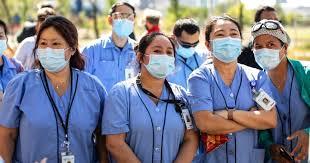Maryland hospitals are struggling to cope with a significant shortage of nurses and the problem is certain to get worse if steps aren’t taken to recruit newcomers to the profession and retain existing workers, according to a new report.
The 2022 State of Maryland’s Health Care Workforce Report, released by the Maryland Hospital Association on Monday, found that one of every four nursing positions is vacant.
“Maryland hospitals face the most critical staffing shortage in recent memory,” according to the association. “High staff turnover, shifting care delivery models, and an insufficient talent pipeline are pushing the workforce to an unsustainable point.”
Maryland is currently short 5,000 full-time registered nurses and 4,000 licensed practical nurses. If steps aren’t taken to lure new workers and reduce the number of nurses leaving the profession, the state could see shortages two or three times larger than current levels by 2035, according to the report.
“The workforce challenges that we are facing are unsustainable,” said Nicole Stallings, the head of external affairs for the MHA.
The report cites several primary factors for the soaring vacancy rates. Nurses are overworked, face occasional violence in the workplace, and feel under-appreciated.
“Workforce challenges predated the COVID-19 pandemic, but the situation is now alarming,” said the association’s CEO, Bob Atlas, in a statement. “Any threat to the workforce of our 60 hospitals and health systems threatens the health and wellness of all Marylanders and stability of our state’s core functions. We cannot take for granted that our excellent health care workforce will always be there.”
Stallings said the association hopes the report offers a roadmap for institutions, educators and policymakers. The nursing shortage is expected to become more acute as the Baby Boom generation ages, she said.
The report found the most populated parts of the state have the highest vacancy rates. Central Maryland, which includes the Baltimore metropolitan region, and the Washington, D.C., suburbs have vacancy rates just over 26%. In Southern and Western Maryland and on the Eastern Shore, vacancy rates are between 13% and 17%.
Many nurses have opted to work for agencies, as “travel nurses,” moving from hospital to hospital, often earning more money and working fewer hours. That phenomenon has pushed up hospital costs while increasing the workload on the remaining staff, which in turn feeds the exodus.
The report makes a number of recommendations:
- Hospitals should consider adopting more worker-friendly schedules, shifts and roles
- Safety policies should be strengthened
- Career advancement opportunities for nurses should be expanded
- Hospitals should streamline the administrative burden nurses face
- Hospitals should expand the “pipeline” by offering stipends and other financial incentives for people considering a career in nursing
- Hospitals should make it easier for military nurses and those who have received training overseas to earn accreditation in Maryland
- Hospitals should increase the number of nursing instructors and nursing school capacity
- State policymakers should promote tele-health, outpatient care and “hospital-at-home” models
“This data-driven report lays the groundwork to address the long-standing, and now urgent need to strengthen our pipeline of nurses in Maryland,” said Ed Lovern, president & CEO of Ascension Saint Agnes and the chairman of the Task Force on Maryland’s Future Health Workforce, in a statement.
“While we won’t fix the nursing shortage overnight, the Task Force urges immediate and concerted actions to shore up the health care workforce we will need for generations to come.”
Stallings said that 20% of nursing students drop out after the first semester. Figuring out how to reduce that drop-off could help address the overall shortage of personnel, she said.
By Bruce DePuyt



Write a Letter to the Editor on this Article
We encourage readers to offer their point of view on this article by submitting the following form. Editing is sometimes necessary and is done at the discretion of the editorial staff.